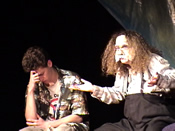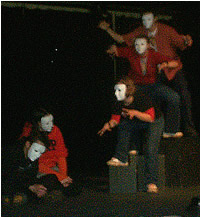Unit
3 - Character
Module
3: Developing Character
Lesson
4 - Physicality & Mask Work
Introduction:
The purpose of this lesson is to allow the student to experience
the use of mark in exploratory drama.
Resources:
Handout: "Mask
Making Ideas and Materials" (Opus Framing PDF);
books
on making masks; plaster bandages or papier mache, vaseline,
scissors, plasticine (or clay), plastic wrap,elastic ties, acrylic
paint, brushes, a variety of mixed media as needed (such as
feathers, wool, hair, glitter, buttons, fabric, etc.), glue
(hot glue, silicon or latex).
An
excellent video: Pierre Lefevre on Acting, (National
Theatre School), National
Film Board of Canada (39 minutes).
Activities:
Masks
can help create characters larger than life, and encourage greater
physical expression (even with previously shy students).
 Latex
mask
Latex
mask |
|
 Latex
mask
Latex
mask |
|
Activity
1 - Looking at Masks:
You
should read the following information and be able to answer
two questions:
1. What are masks made of?
2. What is the purpose of masks?
The
purpose:
|
|
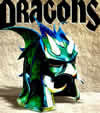
"Dragon Helmut"
Duncan Eagleson
|
Masks
can be made from many different media:
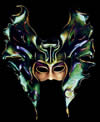
"" "Faerie
Mask"
Duncan Eagleson |
- paper
- leather
- tin
- clay
- latex
- plaster
- papier
mache
- fabric
|
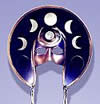 "Lunar Mask"
"Lunar Mask"
Duncan Eagleson |
Activity
4 - Mask, Movement and Music:
| You
are
to prepare a mask and movement piece, without speaking,
to music of your choice. You are to select the music you
think best reflects the character. The movement to the music
may be interpreted a number of ways.You may feel most comfortable
in dance like expression - while others will find it easier
to express movement tied to a specific scene. For example,
the character might be relaxing after a hard day at work,
or making supper, or trying to find a lost item, or painting
a room. Find your best method of expression and interpretation
through the music selected. (20 min.) |
|
Evaluation:
You should design an evaluation for their own mask
work. It should be out of 50, including at least 15 marks for
interpretation, and at least 15 marks for mask construction.
The mask to music scene should be performed for the class, and
the teacher will mark the work based on the evaluation sheet
the you have designed. The teacher may wish to set additional
categories to be included in the evaluation such as: use of
class time, difficulty of work attempted, lyricism, expression,
or use of movement.
Next
Lesson / Previous Lesson









